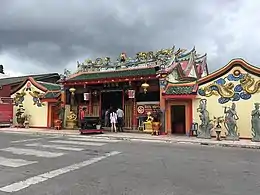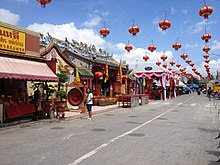Lim Ko Niao
Lim Ko Niao (Chinese: 林姑娘; lit. 'Maiden Lin', Thai: เจ้าแม่ลิ้มกอเหนี่ยว), alternatively Lin Guniang or Lim Kor Niaw and also named Lim Kun Yew,[1] is a deity worshipped by the Chinese people in southern Thailand. She was said to be the sister of Lim Toh Khiam, and who according to legend committed suicide after she failed to persuade her brother to return home, and later began to be worshipped as a goddess by the ethnic Chinese communities in southern Thailand for her sense of filial piety and patriotic feeling for China. A shrine, the Leng Chu Kiang shrine, and a museum dedicated to her exist in Pattani.[2]

Legend
Lim Ko Niao is said to be the sister of Lim Toh Khiam, a Ming dynasty Chinese pirate who settled in the Patani Kingdom in the 16th century. Her existence as an actual person is not known, and her given name is not clear (Ko Niao or Guniang means "maiden" or "young woman"); some sources claimed her given name was Cizhen (慈貞), but a separate tale involving Lim Toh Khiam from Taiwan tells of a sister named Jinlian (金蓮).[3] According to legend, Lim Ko Niao went looking for Lim Toh Khiam when their mother became ill, swearing not to return until she had brought him back. She found Lim Toh Khiam in Patani, where he had married the daughter of the sultan, converted to Islam and was building a mosque for the queen. However, he refused to return, and she then committed suicide by hanging from a janggus tree.[1][4] Before she died, she was said to have cursed the mosque her brother was building, believed to be the Krue Se Mosque, so that it could never be completed. In mourning, the local Chinese later made of statue of her from the tree she had hung herself, and created a small shrine for her, and worshipped her for her sense of filial piety and patriotism.[3]
Her gravestone, located next to the Krue Se Mosque, is dated 1574 and said to have been built by her brother, but it is probably actually created in the early 20th century.[5][3] It is believed that she was originally buried near the harbour which has since become inundated by the sea and the tomb was then moved next to the Krue Se Mosque around 1919.[6]
Worship

The image of Lim Ko Niao was originally placed in small shrine, To Pikong Me, near the Krue Se Mosque.[6] The image was then moved to Leng Chu Kiang (靈慈宮, Líng Cí Gōng). This temple was originally named Zushigong Shrine (祖師公祠) dedicated to Master Qingshui – it was mentioned in Chinese temple record that such a temple existed in Kuala Bekah of Patani in 1547, the oldest-known temple dedicated to Master Qingshui in Southeast Asia.[7][8] It was renamed Leng Chu Kiang after the image of Lim Ko Niao was moved there. Other deities are also worshipped in the temple, such as Mazu and Fude Zhengshen. It is said that a Chinese leader named Luang Cheen Kananurak refurbished the temple and moved the carved image of Lim Ko Niao here in 1879.[9] Lim Ko Niao is now the primary deity worshipped there together with the other deities, and the temple is commonly referred to as the Chao Mae Lim Ko Niao Shrine. The temple was partly rebuilt in 1912 and in 1969.[3]
Other shrines dedicated to Lim Ko Niao have also been established in the neighbouring Songkhla and Yala provinces, and her worship has further spread to a few towns in Central and Upper South Thailand.[6] The worship of Lim To Niao may have started to spread outside of the Patani area in the 1950s,[3] and the Patani shrine has become a tourist attraction for visitors from Malaysia and Singapore since the 1960s.[5]
Festival
A festival, the Chao Mae Lim Ko Niao Festival (Thai: งานสมโภชเจ้าแม่ลิ้มกอเหนี่ยว), is held every year in Pattani, starting on the 14th day of the Chinese New Year. The following day on the 15th, the wooden image of Lim Ko Niao and 17 other statues of various deities worshipped at this temple as well as others from the neighbourhood are carried by the locals in a grand procession.[10] The images are carried across the Pattani River for bathing in the water, and later in the day, the carriers also walked over fire.[9][11]
References
- Bougas, Wayne (1990). "Patani in the Beginning of the XVII Century". Archipel. 39: 133. doi:10.3406/arch.1990.2624.
- "Mystical ties". Bangkok Post. 28 February 2019.
- Mitsuko, Tamaki (December 2007). "The prevalence of the worship of Goddess Lin Guniang by the ethnic Chinese in southern Thailand" (PDF). G-SEC Working Paper. 22.
- "ตำนานเจ้าแม่ลิ้มกอเหนี่ยว". Pattani Heritage City.
- Anthony Reid (30 August 2013). Patrick Jory (ed.). Ghosts of the Past in Southern Thailand: Essays on the History and Historiography of Patani. NUS Press. pp. 7–8. ISBN 978-9971696351.
- Pattana Kitiarsa (ed.). Religious Commodifications in Asia: Marketing Gods. Routledge. p. 103–105. ISBN 9781134074457.
- "福建民間信仰的重要組成部分". kknews. 3 August 2016.
- Bougas, Wayne (1990). "Patani in the Beginning of the XVII Century". Archipel. 39: 129. doi:10.3406/arch.1990.2624.
- "Destination of deities". Nation Thailand. 22 February 2019.
- "Southerners recall sad legend of Lim Ko Niao Thailand". Nation Thailand. 7 February 2020.
- "Lim Ko Niao festival in Pattani: The power of faith". Sawasdee. 17 January 2020.